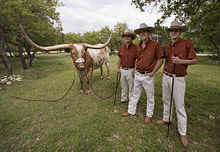Student profile
For Fall 2011, the university enrolled 38,437 undergraduate, 11,497 graduate and 1,178 law students.[105] Out-of-state and international students comprised 9.1% of the undergraduate student body and 20.1% of the total student body, with students from all 50 states and more than 120 foreign countries—most notably, the Republic of Korea, followed by the People's Republic of China, India, Mexico and Taiwan.[106] For Fall 2015, the undergraduate student body was 48.9% male and 51.1% female.[105] The three largest undergraduate majors in 2009 were Biological Sciences, Unspecified Business, and Psychology, while the three largest graduate majors were Business Administration (MBA), Electrical and Computer Engineering, and Pharmacy (PharmD).[106]| Undergraduate | Graduate | Texas | U.S. Census | |
|---|---|---|---|---|
| African American | 4% | 3.0% | 12.6% | 12.9% |
| Asian American | 23% | 7.2% | 4.4% | 4.6% |
| Non-Hispanic White | 45% | 53.0% | 45.3% | 65.1% |
| Hispanic American | 21% | 10.0% | 37.6% | 15.8% |
| Native American | 1% | 0.2% | 1.3% | 1.0% |
| Foreign | 4% | 22.4% | N/A | N/A |
Residential life
The campus has fourteen residence halls, the newest of which opened in Spring 2007. On-campus housing can hold more than 7,100 students.[109] Jester Center is the largest residence hall with its capacity of 2,945.[110] Academic enrollment exceeds the on-campus housing capacity; as a result, most students must live in private residence halls, housing cooperatives, apartments, or with Greek organizations and other off-campus residences. The Division of Housing and Food Service, which already has the largest market share of 7,000 of the estimated 27,000 beds in the campus area, plans to expand to 9,000 beds.[111]Student organizations
The university recognizes more than 1,000 student organizations.[112] In addition, it supports three official student governance organizations that represent student interests to faculty, administrators, and the Texas Legislature. Student Government, established in 1902, is the oldest governance organization and represents student interests in general.[113] The Senate of College Councils represents students in academic affairs and coordinates the college councils,[114] and the Graduate Student Assembly represents graduate student interests.[115] The University Unions Student Events Center serves as the hub for student activities on campus.[116] The Friar Society serves as the oldest honor society at the university.[117] Texas 4000 for Cancer is another student organization, which also doubles as an Austin-based nonprofit, that hosts a 4,500-mile bike ride from Austin, Texas to Anchorage, Alaska, thus far raising over $5 million for cancer research and patient support services since its inception in 2004.[118]Greek life
The University of Texas at Austin is home to an active Greek community. Approximately 14 percent of undergraduate students are in fraternities or sororities.[119] With more than 65 national chapters, the university's Greek community is one of the nation's largest.[119] These chapters are under the authority of one of the school's six Greek council communities, Interfraternity Council, National Pan-Hellenic Council, Texas Asian Pan-Hellenic Council, Latino Pan-Hellenic Council, Multicultural Greek Council and University Panhellenic Council.[120] Other registered student organizations also name themselves with Greek letters and are called affiliates. They are not a part of one of the six councils but have all of the same privileges and responsibilities of any other organization.[121] According to the Office of the Dean of Students' mission statement, Greek life promotes cultural appreciation, scholarship, leadership, and service.[122] Most Greek houses are west of the Drag in the West Campus neighborhood.Media
See also: Texas Student Media
Students express their opinions in and out of class through periodicals including Study Breaks Magazine, Longhorn Life, The Daily Texan (the most award-winning daily college newspaper in the United States),[123] and the Texas Travesty. Over the airwaves students' voices are heard through Texas Student Television (K29HW-D) and KVRX Radio.The Computer Writing and Research Lab of the university's Department of Rhetoric and Writing also hosts the Blogora, a blog for "connecting rhetoric, rhetorical methods and theories, and rhetoricians with public life" by the Rhetoric Society of America.[124]
Traditions
The "Silver Spurs" with the university's mascot, Bevo

No comments:
Post a Comment